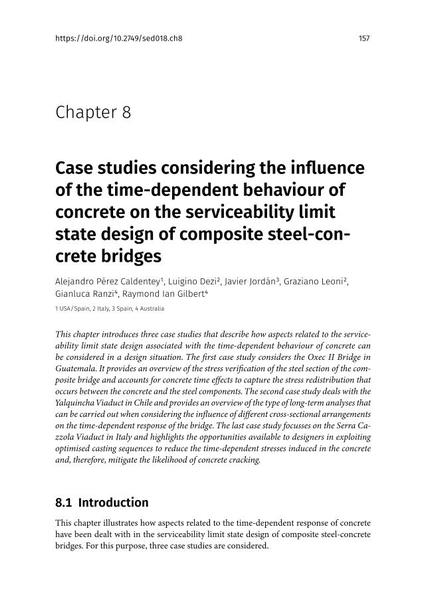Case studies considering the influence of the time-dependent behaviour of concrete on the serviceability limit state design of composite steel-concrete bridges

|
|
|||||||||||
Bibliografische Angaben
| Autor(en): |
Alejandro Pérez Caldentey
Luigino Dezi Javier Jordán (Technical Director, Pedelta) Graziano Leoni Gianluca Ranzi Raymond Ian Gilbert |
||||
|---|---|---|---|---|---|
| Medium: | Buchkapitel | ||||
| Sprache(n): | Englisch | ||||
| Verlag: | International Association for Bridge and Structural Engineering | ||||
| Veröffentlicht in: | Zürich, Schweiz | ||||
| Veröffentlicht in: | Time-dependent behaviour and design of composite steel-concrete structures | ||||
|
|||||
| Seite(n): | 157-188 | ||||
| Anzahl der Seiten (im PDF): | 32 | ||||
| Jahr: | 2021 | ||||
| DOI: | 10.2749/sed018.ch8 | ||||
| Abstrakt: |
This chapter introduces three case studies that describe how aspects related to the serviceability limit state design associated with the time-dependent behaviour of concrete can be considered in a design situation. The first case study considers the Oxec II Bridge in Guatemala. It provides an overview of the stress verification of the steel section of the composite bridge and accounts for concrete time effects to capture the stress redistribution that occurs between the concrete and the steel components. The second case study deals with the Yalquincha Viaduct in Chile and provides an overview of the type of long-term analyses that can be carried out when considering the influence of different cross-sectional arrangements on the time-dependent response of the bridge. The last case study focusses on the Serra Cazzola Viaduct in Italy and highlights the opportunities available to designers in exploiting optimised casting sequences to reduce the time-dependent stresses induced in the concrete and, therefore, mitigate the likelihood of concrete cracking. |
||||
| Stichwörter: |
Beton Stahl-Beton-Verbundbrücke zeitabhängiges Verhalten
|
||||
| Copyright: | © 2021 International Association for Bridge and Structural Engineering | ||||

